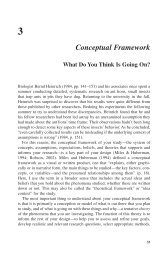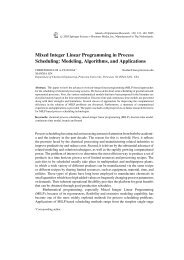Qualitative Research Basics: A Guide for Engineering Educators
Qualitative Research Basics: A Guide for Engineering Educators
Qualitative Research Basics: A Guide for Engineering Educators
Create successful ePaper yourself
Turn your PDF publications into a flip-book with our unique Google optimized e-Paper software.
transcribe the recorded interviews, and to read these over carefully afterward against the<br />
voice recording, revising rather than doing the entire transcription yourself.<br />
The quality of the interview data has a significant impact on the overall quality and<br />
trustworthiness of the outcomes of the study. Kvale (1996) lists the following criteria <strong>for</strong><br />
determining the quality of an interview:<br />
• The extent of spontaneous, rich, specific, and relevant answers from the<br />
interviewee<br />
• The degree to which the interviewer’s questions are shorter than the subjects’<br />
answers<br />
• The degree to which the interviewer follows up and clarifies the meanings of the<br />
relevant aspects of the answers<br />
• The extent to which the interview is interpreted throughout the interview<br />
• The frequency with which the interviewer attempts to verify his or her<br />
interpretations of the subject’s answers in the course of the interview<br />
• The degree to which the interview is self-containing – it is a story contained in<br />
itself that hardly requires many extra descriptions and explanations.<br />
Recent Perspectives on Interviewing<br />
The classic view of interviewing has tended towards a positivist perspective, seeking to<br />
maintain the interviewer as a neutral party who simply records the in<strong>for</strong>mation and has no<br />
influence on the resulting data. More recently, however, it has been recognized that the<br />
interviewer plays an important role, even when there is an attempt to maintain this<br />
neutrality. Fontana and Frey (2005) discuss the “empathetic” view of interviewing,<br />
pointing out that, “interviewing is not merely the neutral exchange of asking questions<br />
and getting answers. Two (or more) people are involved in this process, and their<br />
exchanges lead to the creation of a collaborative ef<strong>for</strong>t called the interview. The key here<br />
is the ‘active’ nature of this process…that leads to a contextually bound and mutually<br />
created story – the interview” (p. 696, italics in original).<br />
How does this contextualization occur? One way is the how the interview is framed. How<br />
one describes those being interviewed (pathological deviants vs. diverse individuals who<br />
are ostracized) leads to different understandings and uses of the data (Fontana & Frey,<br />
2005). Fontana and Frey also point out that the researcher influences the data by deciding<br />
which aspects to include and which to exclude from the narrative that results from the<br />
data. In considering the role of the researcher, there are a variety of approaches. At one<br />
extreme, the role of the researcher is ignored, even though it is always present. At the<br />
other extreme, steps are taken to enhance the interaction between interviewer and<br />
interviewee, making them equal partners in creating the narrative. “<strong>Research</strong>ers are<br />
attempting to minimize status differences and are doing away with the traditional<br />
hierarchical situation in interviewing. Interviewers can show their human side and can<br />
answer questions and express feelings” (Fontana & Frey, 2005, p. 711). By becoming a<br />
partner in the interview, researchers can more explicitly recognize the role that the<br />
interviewer plays in the interview and encourage those being interviewed to be more<br />
open about their personal responses and emotions regarding the topic. Feminist scholars<br />
28
















